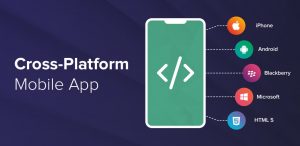 The cost of developing and launching apps for Android, iOS, and other ‘smart’ devices is rising day by day due to the lack of skilled developers. Apps for Android can be written in Java, and iOS ones in Objective-C, or Swift. The same code needs to be written multiple times. It results in waste of time and resources. Thus, slowly, developers are moving towards cross-platform development rather than going with native engineering.
The cost of developing and launching apps for Android, iOS, and other ‘smart’ devices is rising day by day due to the lack of skilled developers. Apps for Android can be written in Java, and iOS ones in Objective-C, or Swift. The same code needs to be written multiple times. It results in waste of time and resources. Thus, slowly, developers are moving towards cross-platform development rather than going with native engineering.
Thanks to cross-platform frameworks, developers need to create a single app that’s compatible with multiple operating systems. New tools and approaches are helping engineers to improve the application behavior, performance of these common frameworks.
Cross-platform’s Relevance Should Increase Even Further In 2020
One of the significant upsides of cross-platform development is the ease of code reusability. A considerable amount of time and efforts can be saved as a single code is used for several platforms.
Developers working on cross-platform apps do not need to be pro in specific languages like Java, Swift, or Objective-C. Proficiency in CSS3, JavaScript, and HTML can be sufficient. Most importantly, engineers face lesser hurdles while working on these apps.
Efforts and budget for marketing can be reduced significantly, as the app can be launched on multiple platforms simultaneously. The software can be launched quickly as the turnaround time is quick. A rough idea can be turned into a working mobile application quickly.
These frameworks are cost-effective and easy to manage. They offer consistency in the user interface, plus, cloud integration can be done with ease. During 2020, cross-platform frameworks are expected to be tweaked further so that they can work with ‘smart’ devices as well.
New Operating Systems Cannot Be Ignored
The trade war has begun. The United States government is forcing American technology and services firms to not to work with Huawei.
Google’s parent Alphabet has already restricted Huawei from using some of the components of the Android OS. The next version of the OS won’t be available on the Beijing-based company’s devices. Such Trade war would motivate tech-giants to launch country-specific operating systems.
Huawei recently launched its HongmengOS (operating system). The company declared that the brand’s smartphones, smart wearables, smart speakers, and in-vehicle systems would be shipped with the in-house operating system during the coming months. Huawei sells more phones than Apple, so, application developers won’t prefer missing out the new operating system by launching only native apps.
Plus, devices with newer operating systems like KaiOS are increasing slowly but steadily in developing countries. Currently, small numbers of developers create apps for devices that work on web-based KaiOS powered by Mozilla’s B2G. The applications are built with CSS/JS/HTML stack.
Thus, more and more brands would prefer going cross-platform during the coming years. A trustworthy custom mobile app development company can help in creating an excellent application for multiple platforms.
The BYOD- Bring Your Own Device Trend is set to Grow Further
May it be a hotel, manufacturing unit, restaurant, or a commercial trading firm, almost every organization has its in-house mobile or web-based app. Various procedures are performed using the same daily.
These days, several companies allow their employees to bring their mobile devices, laptops while at the office. Most of the workforce prefers the same instead of using a company-provided desktop for accessing the organization’s apps as well as data. Thus, businesses need to ensure their in-house apps can work on various types of devices with different operating systems that their workforce uses.
Opting for a unique environment (cross-platform) allows the app to work on different platforms.
Here’re Top Cross-platform Frameworks To Look Out For In 2020
- Google’s Flutter UI Toolkit For Cross-platform Development
Launched in 2017, Google’s cross-platform development toolkit, Flutter has managed to create its fan following in the developers’ community. Google recently declared that it intends to use the framework in other devices, including web apps, and Google Home Hub as well.
Google’s Dart language is used for writing Flutter apps. Developers find it easy as it reduces development time. Adding features, fixing bugs, and testing requires just a few seconds. The ‘hot reload’ makes rapid testing easy. Dart and Flutter plugins are readily available in Android Studio.
Alibaba (eCommerce), Google Ads, Reflectly, Hamilton Musical, and the New York Times (KENKEN puzzle) app use Google’s Flutter framework. It is expected to show a lot of improvement and several new features in 2020.
- Microsoft’s Xamarin
When it comes to developing native app-like interfaces, engineers find Xamarin as the most competitive one. It resolves most of the limitations that surround other multi-system frameworks.
Launched in 2011 and acquired by Microsoft in 2016, Xamarin is another popular cross-platform framework. A C#-shared codebase enables engineers to use the same Xamarin tools for writing iOS and Android apps.
More than 15000 small and large companies use Xamarin for their mobile apps and wearable devices.
Adding functionality to the app is easy as developers can download simple plugins from the Xamarin component store.
Coding becomes easy as Xamarin offers all the existing iOS and Android SDK in C#. Integrating the app with popular backend systems is hasslefree.
- Apache Cordova
Owned by Adobe, Apache Cordova was earlier referred to as PhoneGap. It offers a different approach compared to Xamarin as its tools can be used for building apps in common web development languages like JavaScript, CSS, and HTML.
The route is not recommended for building games as a fair amount of native functionalities remain unavailable. It is recommended for building essential apps with minimal financial investment.
Apache Cordova apps work a bit slower compared to those built using other cross-platform frameworks. However, a large number of plugins, massive community support, and access to third-party tools have helped the platform to remain in the competition. Apache Cordova also allows developers to create the app, preview the same on the device, and make changes to the code accordingly. The app can be shared with other developers in the team for their inputs.
- React Native
Introduced by Facebook to the world in 2015, React Native has gained popularity as it allows developers to create a native-like UI using JavaScript framework. Native code can be combined with components written in Swift, Java, or Objective-C. The feature helps engineers while manually optimizing some aspects from the application.
Developers can create native-like user interface as they get access to high-quality native functionalities. A supportive community and the availability of numerous plugins make like easy.
Brands like UberEats, Bloomberg, Airbnb, and Facebook Ads Manager app are made with React Native. The list of users is extensive and includes some Fortune 500 companies as well.
Are you looking for a firm that offers reliable mobile app development services India? Try discussing your requirements with genius developers at Smart Sight Innovations. The smartphone app development company has a very accomplished team of developers.











